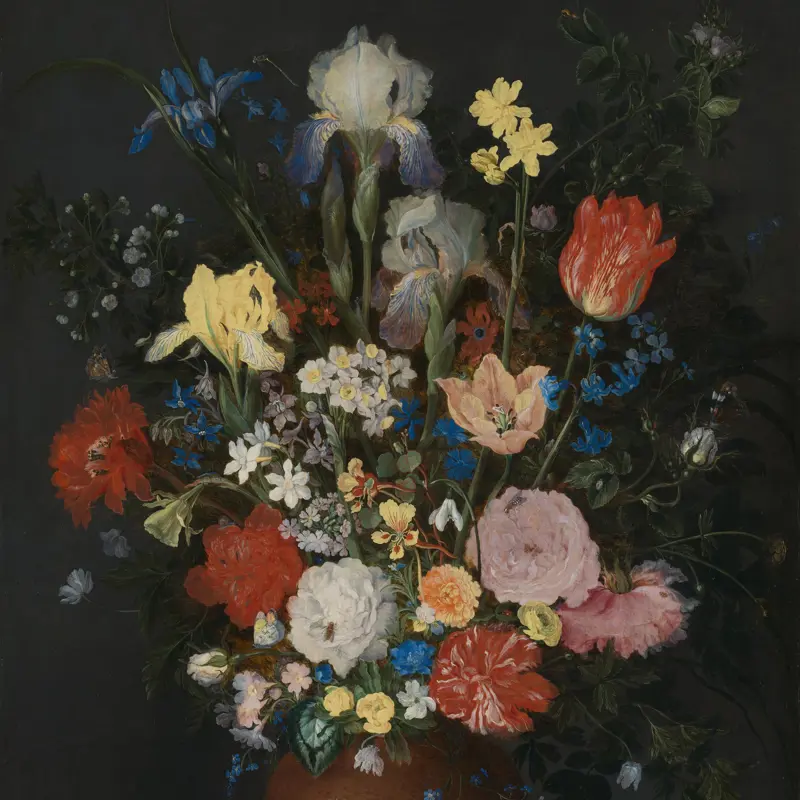Jan Brueghel the Elder, 'The Adoration of the Kings', 1598
About the work
Overview
Jan Brueghel seems to have squeezed a whole world into his tiny picture. A crowd waits patiently for a turn to come closer to the little child on his mother’s knee. The baby is bare, to show us that he’s a real human baby, but the silvery arrow of light tells us something more.
The old man kneeling is a king. He wears no crown and neither do the kings on either side of him. It’s the child that wears the true crown – a delicate halo that would outshine any earthly crown, for it announces him as the Son of God.
Brueghel’s delicate picture was painted in body colour (watercolour which is mixed with white pigment to make it opaque) on vellum and was made to be handled. It was a talking point but also a reminder of a great religious event. Its owner would have enjoyed the strange mixture of beauty and ugliness that the artist often put into his pictures, bringing everyday people into incidents of great significance.
Key facts
Details
- Full title
- The Adoration of the Kings
- Artist
- Jan Brueghel the Elder
- Artist dates
- 1568 - 1625
- Date made
- 1598
- Medium and support
- Bodycolour on parchment
- Dimensions
- 32.9 × 48 cm
- Inscription summary
- Signed; Dated
- Acquisition credit
- Presented by Alfred A. de Pass, 1920
- Inventory number
- NG3547
- Location
- Room 27
- Collection
- Main Collection
- Frame
- 17th-century Flemish Frame
Provenance
Additional information
Text extracted from the ‘Provenance’ section of the catalogue entry in Gregory Martin, ‘National Gallery Catalogues: The Flemish School: circa 1600–circa 1900’, London 1986; for further information, see the full catalogue entry.
Bibliography
-
1935C. de Tolnay, Pierre Bruegel l'Ancien, Brussels 1935
-
1969G. Marlier, Pierre Brueghel le Jeune, Brussels 1969
-
1970G. Martin, The Flemish School, circa 1600-circa 1900, London 1970
-
1979K. Ertz, Jan Brueghel der Ältere. Die Gemälde, Cologne 1979
-
1980M. Klinge, Bruegel: Une dynastie de peintres (exh. cat. Palais des Beaux-Arts, 18 September - 18 November 1980), Brussels 1980
-
1986Martin, Gregory, National Gallery Catalogues: The Flemish School, circa 1600 - circa 1900, London 1986
-
1990P.C. Sutton, Northern European Paintings in the Philadelphia Museum of Art: From the Sixteenth Through the Nineteenth Century, The Hague 1990
-
1996Y. Pinson, 'Connotations of Sin and Heresy in the Figure of the Black King in Some Northern Renaissance Adorations', Artibus et historiae, XVII/34, 1996, pp. 159-75
-
2001
C. Baker and T. Henry, The National Gallery: Complete Illustrated Catalogue, London 2001
-
2002D. Bomford et al., Underdrawings in Renaissance Paintings (exh. cat. The National Gallery, 30 October 2002 - 16 February 2003), London 2002
About this record
If you know more about this work or have spotted an error, please contact us. Please note that exhibition histories are listed from 2009 onwards. Bibliographies may not be complete; more comprehensive information is available in the National Gallery Library.





